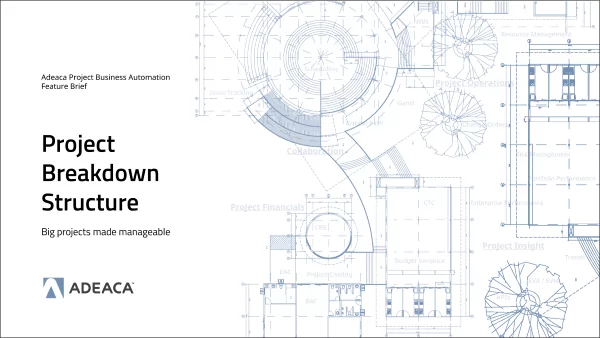As projects become larger and more complex, project businesses need a system that can handle it. The fact is project businesses are struggling to find an efficient way to manage the increased number of tasks, costs and risk that come with bigger projects.
Unfortunately, most businesses simply don’t have a way to manage such massive projects, and often fail to keep track of every task and everyone involved on those tasks. As a result, potential issues get overlooked, becoming major problems down the road, and ultimately, projects are delivered late and over budget.
The Project Breakdown Structure (PBS), as part of Project Business Automation, provides another layer of organization, allowing a big project to be broken up into more manageable embedded projects, while maintaining a single hierarchical structure. This structure makes it a lot easier to manage complex projects by providing full project-level of visibility and control at all levels for all involved.
PBS: Breakdown Your Big Projects Horizontally and Vertically
The PBS allows any number of embedded projects and levels of embedded projects to be created within a single parent project. Each embedded project, including all operational and financial aspects, can be managed by individual project teams. This means each embedded project can have its own work breakdown structure (WBS) and cost breakdown structure (CBS), but still automatically integrate into the Parent Project to ensure higher-level visibility and controls.
There are two dimensions in which the PBS can help you manage big projects:
- Breadth: break out your big project into phased projects that happen in sequence (e.g. Design > Engineering > Fabrication > Installation).
- Depth: create as many levels of embedded projects as you need (e.g. Construction Project / Engineering / Mechanical, Electrical, Environmental).
The PBS enables project businesses to manage large projects both horizontally and vertically. For as many embedded projects as you have, they all automatically roll up into the same Parent Project.
This is critical to allowing different divisions, managers, controllers, etc. to work on their assigned part of the project independently, while ensuring any changes are reflected across the entire project hierarchy. It’s a lot easier to tackle individual aspects of a project, than trying to wrangle the hundreds or even thousands of tasks involved in a single WBS.
Seamlessly Embed Projects in One Structure
Large, complex projects involve a lot of moving parts and a lot of hands on deck. Without an efficient system in place to make it more manageable, there’s no way to avoid costly mistakes. When different divisions and departments can manage their costs and operations of the project separately, while still having everything roll up into the Parent Project, big projects are more likely to be delivered on time and within budget.











